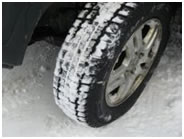Du Fresne's Auto Repair Winter Tire
 Winter tire technology is more advanced than most drivers realize. All too often, people are counting on the tire equivalent of an 8-track, when they should be demanding an iPod.
Winter tire technology is more advanced than most drivers realize. All too often, people are counting on the tire equivalent of an 8-track, when they should be demanding an iPod.
In decades past, winter tires were made distinct only by their tread design. The so-called snow tires had large, knobby lugs that provided good traction in the snow. The rubber itself was the same as on regular tires, and they did not perform well on wet roads, packed snow or ice. Deep and loose snow were really all they were good for. In addition, they were not smooth to ride on and made a lot of noise.
Next, all season tires appeared. These were like a combination of winter and summer performance tires. They did well in both hot and snowy conditions, though it was still a good idea to consider actual winter tires.
Today's winter tires are excellent in all sorts of winter conditions. Unlike regular tires, which become inflexible and hard under 45 degrees, whether or not it's snowing, winter tires are designed to work in icy, snowy and cold conditions. They are better at moving snow and water, which is the key to traction when the roads are slick for any reason. Winter tires accomplish this by using a micro-pore compound that bites snow and ice, as well wider grooves that run the tread's circumference. The shape of the grooves and lugs tosses packed snow out of the tread during tire rotations. This allows the tread to be open when it once again contacts the road.
Something else that winter tires have is several sipes, which are thin slits in the tread. The sipe edges grab snow and ice for traction, and to get ice and water out of the tread. Winter tires also have a more round casing, which cuts the surface of the snow. While regular treads can actually become packed with slush, winter tires provide 25 percent to 50 percent increased traction than even the all-season varieties. All season tires may also reduce safety by taking 42 percent longer to come to a stop.
You can see how much better things are with winter tires than when snow tires were the only option available. Think of it this way: Taking an icy corner can cause the back tires to try to “outrun” the front tires. This makes the back end slide out and spin the vehicle. Only having winter tires on the front can actually make this worse, as the front tires will be excellent at slowing down. Still, most of the braking and steering happens from the front, and excellent traction is important. For this reason, tire manufacturers tell dealers to put winter tires on the back of a vehicle whenever winter tires are going on the front during domestic or import auto repair. Having winter tires on all four wheels is really the best thing to do.
Come to Du Fresne's Auto repair for the ultimate in auto diagnostic, winter tires, an oil change, brakes and general car repair in Beaverton. Whether you need American, Asian or European auto repair, we have the team you can trust.